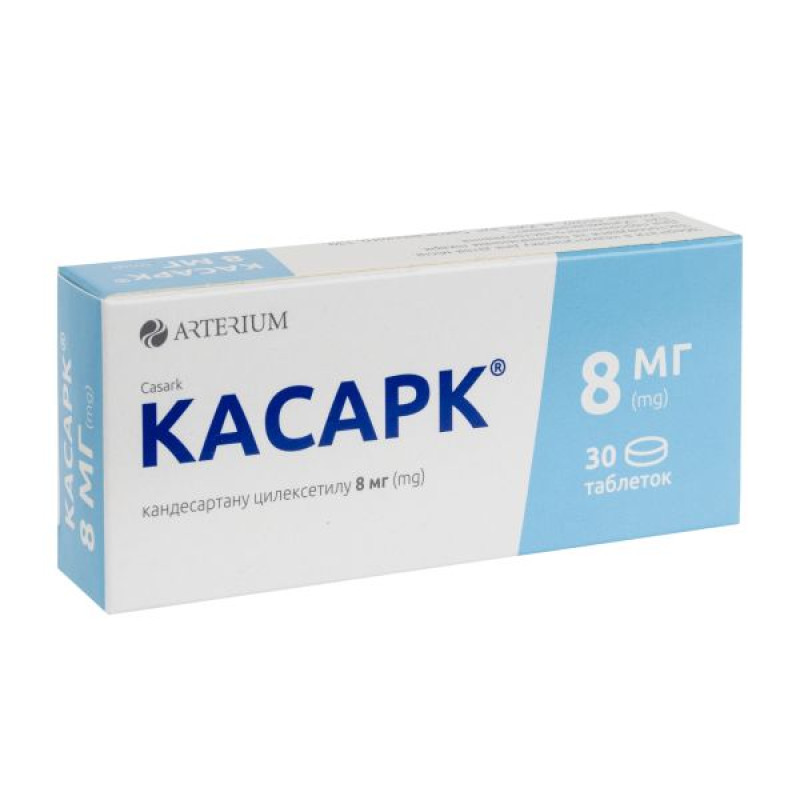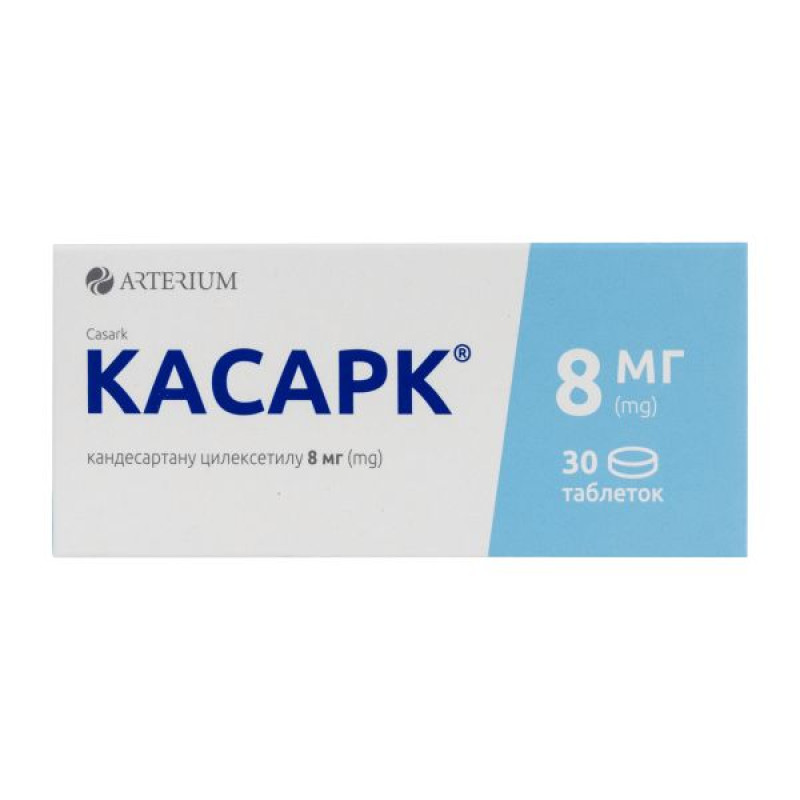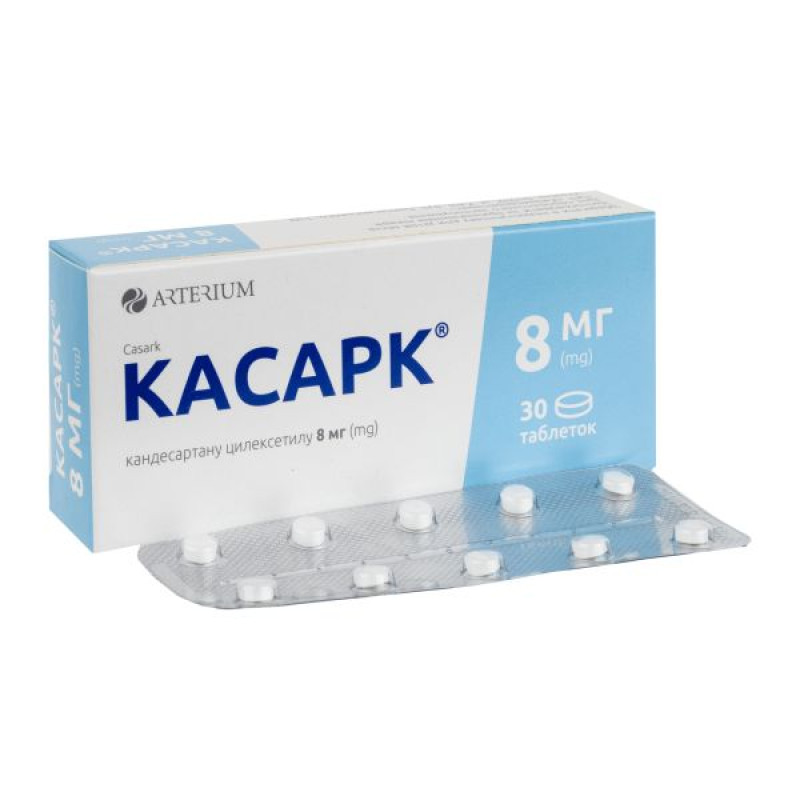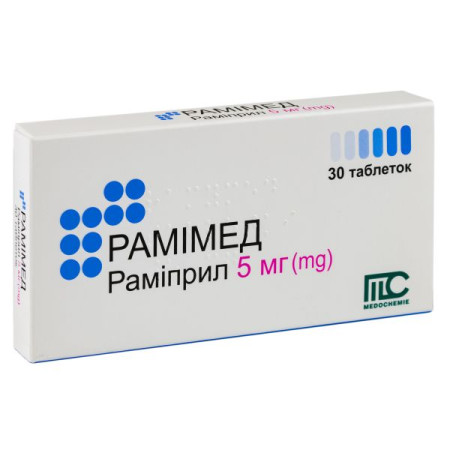Kasark tablets 8 mg No. 30

Instructions Kasark tablets 8 mg No. 30
Composition
active ingredient: candesartan cilexetil;
1 tablet contains candesartan cilexetil, calculated as 100% substance, 8 mg;
Excipients: carmellose calcium; corn starch; hydroxypropylcellulose; lactose monohydrate; magnesium stearate; polyethylene glycol (PEG 8000).
Dosage form
Pills.
Main physicochemical properties: tablets of white or almost white color, round shape, with a biconvex surface. Marbling is allowed on the surface of the tablet.
Pharmacotherapeutic group
Angiotensin II receptor antagonists. ATC code C09C A06.
Pharmacological properties
Pharmacodynamics
Angiotensin II is the main vasoactive hormone of the renin-angiotensin-aldosterone system, which plays a role in the pathophysiological mechanism of hypertension, heart failure, and other cardiovascular diseases. It also plays a role in the pathogenesis of end-stage hypertrophy and organ damage. The main physiological effects of angiotensin II, such as vasoconstriction, stimulation of aldosterone secretion, regulation of salt and water homeostasis, and stimulation of cell growth, occur with the participation of type 1 (AT1) receptors.
Candesartan cilexetil is an orally administered prodrug. It is rapidly converted to the active substance, candesartan, by ester hydrolysis during absorption from the gastrointestinal tract. Candesartan is an angiotensin II receptor antagonist (ARBI), selective for AT1 receptors, with tight binding and slow dissociation from the receptor. It does not exhibit agonist activity.
Candesartan does not inhibit angiotensin-converting enzyme (ACE), which converts angiotensin I to angiotensin II and destroys bradykinin. No effect on ACE or enhancement of bradykinin or substance P was observed. In controlled clinical trials comparing candesartan with ACE inhibitors, the incidence of cough was lower in patients receiving candesartan cilexetil. Candesartan does not bind to receptors for other hormones and does not block ion channels important in the regulation of the cardiovascular system. Antagonism of angiotensin II (AT1) receptors leads to a dose-dependent increase in plasma renin, angiotensin I and angiotensin II levels, as well as a decrease in plasma aldosterone concentrations.
Arterial hypertension
In arterial hypertension, candesartan causes a dose-dependent, long-lasting decrease in blood pressure.
The antihypertensive effect is due to a decrease in systemic peripheral resistance without a reflex increase in heart rate. There is no evidence of serious or excessive hypotension after the first dose or of a withdrawal syndrome after discontinuation of treatment.
After a single dose of candesartan cilexetil, the onset of the antihypertensive effect is usually observed within 2 hours. With long-term treatment, the greatest reduction in blood pressure at all doses is usually achieved within 4 weeks and is maintained during long-term treatment. According to the meta-analysis, the average additional effect when increasing the dose from 16 mg to 32 mg 1 time per day was small. Taking into account interindividual differences, a more pronounced than average effect can be expected in some patients. Candesartan cilexetil, when taken once a day, provides an effective and smooth reduction in blood pressure over 24 hours with a small difference between the maximum and minimum effects during the dosing interval. The antihypertensive effect and tolerability of candesartan and losartan were compared in two randomised, double-blind studies involving a total of 1268 patients with mild to moderate hypertension. The minimum reduction in blood pressure (systolic/diastolic) was 13.1/10.5 mmHg for candesartan cilexetil 32 mg once daily and 10/8.7 mmHg for losartan potassium 100 mg once daily (difference in blood pressure reduction 3.1/1.8 mmHg, p<0.0001/p<0.0001).
An additional reduction in blood pressure is observed when candesartan cilexetil is used together with hydrochlorothiazide. An enhanced antihypertensive effect is also observed when candesartan cilexetil is combined with amlodipine or felodipine.
Candesartan increases renal blood flow and either has no effect or increases glomerular filtration rate by reducing renal vascular resistance and filtration fraction. In a 3-month clinical study in patients with hypertension and type 2 diabetes mellitus and microalbuminuria, antihypertensive treatment with candesartan cilexetil reduced urinary albumin excretion. There are currently no data on the effect of candesartan on the progression of diabetic nephropathy. The effect of candesartan cilexetil at doses of 8-16 mg (mean dose 12 mg) once daily on cardiovascular morbidity and mortality was evaluated in a randomized clinical trial involving 4,937 elderly patients (aged 70-89 years; 21% aged 80 years and older) with mild to moderate hypertension, with a median duration of 3.7 years (Cognition and Prognosis in the Elderly Study).
Patients received candesartan cilexetil or placebo with other antihypertensive therapy added as needed. BP decreased from 166/90 to 145/80 mm Hg in the candesartan group and from 167/90 to 149/82 mm Hg in the control group. There was no statistically significant difference in the rate of major cardiovascular events. There were 26.7 events per 1000 patient-years in the candesartan group compared with 30 events per 1000 patient-years in the control group.
Heart failure
Treatment with candesartan cilexetil reduces mortality, reduces hospitalizations for heart failure, and improves symptoms in patients with left ventricular systolic dysfunction, as demonstrated in the Candesartan in Heart Failure - Evaluation of Mortality and Morbidity Reduction (CHARM) trial. This placebo-controlled, double-blind study program in patients with chronic heart failure (CHF) in New York Heart Association (NYHA) functional classes II-IV consisted of three separate studies: CHARM-Alternative (n=2028) in patients with LVEF ≤ 40% who were not taking ACE inhibitors due to intolerance (mainly due to cough, 72%), CHARM-Add-on (n=2548) in patients with LVEF ≤ 40% who were taking ACE inhibitors, and CHARM-Maintain (n=3023) in patients with LVEF > 40%.
In the CHARM-Alternative study, the composite endpoint of cardiovascular mortality or first hospitalization for CHF was significantly reduced with candesartan compared with placebo (relative risk reduction of 23%).
The composite endpoint of all-cause mortality or first hospitalization for CHF was also significantly reduced in the candesartan group, with an absolute difference of 6%.
Both components of these composite endpoints – mortality and morbidity (hospitalization for CHF) – supported the beneficial effect of candesartan. Treatment with candesartan cilexetil resulted in an improvement in NYHA functional class (p=0.008).
In the CHARM-Add-on study, the composite endpoint of cardiovascular mortality or first hospitalization for CHF was significantly reduced in the candesartan group compared with placebo (relative risk reduction of 15%). The composite endpoint of all-cause mortality or first hospitalization for CHF was also significantly reduced in the candesartan group, with an absolute difference of 3.9%. Both components of these composite endpoints – mortality and morbidity – support the beneficial effect of candesartan. Treatment with candesartan cilexetil resulted in an improvement in NYHA functional class (p=0.02).
In the CHARM-Preservation study, a statistically significant reduction in the composite endpoints of cardiovascular mortality or first hospitalization for CHF was not achieved.
All-cause mortality was not statistically significant when analyzed separately in each of the three CHARM studies. However, all-cause mortality was also assessed in the combined CHARM-Alternative and CHARM-Add-on populations, HR 0.88 (95% CI: 0.79–0.98, p=0.018) and all three studies, HR 0.91 (95% CI: 0.83–1.00, p=0.055). The beneficial effect of candesartan was consistent regardless of age, gender, and concomitant medication. Candesartan was also effective in patients receiving concomitant beta-blockers and ACE inhibitors, with the beneficial effect being obtained regardless of whether the patient was taking the ACE inhibitor at the target dose recommended by treatment guidelines. In patients with CHF and reduced left ventricular systolic function (left ventricular ejection fraction ≤ 40%), candesartan reduces systemic vascular resistance and pulmonary capillary wedge pressure, increases plasma renin activity and angiotensin II concentrations, and reduces aldosterone levels.
Pharmacokinetics
After oral administration of candesartan cilexetil, it is converted to the active substance candesartan. The absolute bioavailability of candesartan is approximately 40% after oral administration of candesartan cilexetil solution. The relative bioavailability of the tablet formulation compared to the same oral solution is approximately 34% with very little variability. The calculated absolute bioavailability of the tablet is therefore 14%. The mean peak serum concentration (Cmax) is reached 3-4 hours after tablet administration. The serum concentration of candesartan increases linearly with increasing doses within the therapeutic dose range. No gender differences in the pharmacokinetics of candesartan have been identified. The area under the serum concentration versus time curve (AUC) of candesartan is not significantly affected by food. Candesartan is extensively bound to plasma proteins, with a binding affinity of more than 99%. The apparent volume of distribution of candesartan is 0.1 l/kg.
The bioavailability of candesartan is not affected by food.
Metabolism and excretion
Candesartan is excreted mainly unchanged in the urine and bile, and only to a minor extent by hepatic metabolism (CYP2C9). Based on in vitro data, no in vivo interactions with drugs metabolized by cytochrome P450 isoenzymes CYP1A2, CYP2A6, CYP2C9, CYP2C19, CYP2D6, CYP2E1 or CYP3A4 are expected. The terminal elimination half-life of candesartan is approximately 9 hours. There is no accumulation of the drug after multiple administration.
The total plasma clearance of candesartan is approximately 0.37 ml/min/kg with a renal clearance of approximately 0.19 ml/min/kg. Renal elimination of candesartan occurs by both glomerular filtration and active tubular secretion. Following oral administration of 14C-labelled candesartan cilexetil, approximately 26% of the dose is excreted in the urine as candesartan and 7% as an inactive metabolite, while approximately 56% of the dose is recovered in the faeces as candesartan and 10% as an inactive metabolite.
Pharmacokinetics in special patient populations
In elderly subjects (>65 years of age), Cmax and AUC of candesartan were increased by approximately 50% and 80%, respectively, compared with young subjects. However, the BP response and the incidence of adverse events were similar after dosing with Candesartan in young and elderly subjects.
In patients with mild and moderate renal impairment, Cmax and AUC of candesartan increased with repeated dosing by approximately 50% and 70%, respectively, but t1/2 remained unchanged compared to patients with normal renal function. The corresponding changes in patients with severe renal impairment were approximately 50% and 110%, respectively. The terminal t1/2 of candesartan was approximately doubled in patients with severe renal impairment. The AUC of candesartan in patients on hemodialysis was close to that in patients with severe renal impairment.
In two studies involving patients with mild to moderate hepatic impairment, an increase in mean AUC of candesartan of approximately 20% in one study and 80% in the other study was observed. There is no experience in patients with severe hepatic impairment.
Indication
Treatment of essential hypertension in adults.
Treatment of adult patients with heart failure and impaired left ventricular systolic function (left ventricular ejection fraction ≤ 40%) as add-on therapy to ACE inhibitors or in cases of intolerance to ACE inhibitors.
Contraindication
Hypersensitivity to candesartan cilexetil or to any of the excipients.
Severe hepatic insufficiency and/or cholestasis.
Pregnant women or women planning to become pregnant (see section “Use during pregnancy or breastfeeding”)
Interaction with other medicinal products and other types of interactions
Drugs studied in clinical pharmacokinetic studies include hydrochlorothiazide, warfarin, digoxin, oral contraceptives (i.e. ethinyl estradiol/levonorgestrel), glibenclamide, nifedipine and enalapril. No clinically significant pharmacokinetic interactions were observed with these drugs.
Concomitant use of potassium-sparing diuretics, potassium supplements, salt substitutes containing potassium, or other medicinal products (e.g. heparin) may increase potassium levels. Potassium levels should be monitored appropriately.
Reversible increases in serum lithium concentrations and toxicity have been reported during concomitant administration of lithium and ACE inhibitors.
A similar effect may be observed with ARA II. The use of candesartan with lithium is not recommended. If the combination is confirmed, careful monitoring of serum lithium levels is recommended.
As with ACE inhibitors, concomitant use of ARA II and NSAIDs may lead to an increased risk of worsening of renal function, including possible acute renal failure and an increase in serum potassium, particularly in patients with compromised renal function at the start of treatment. The combination should be used with caution, especially in elderly patients. The patient should be adequately hydrated and attention should be paid to monitoring renal function after initiation of concomitant therapy and periodically thereafter.
Application features
Kidney failure
As with other agents that inhibit the renin-angiotensin-aldosterone system, changes in renal function may be expected in susceptible patients taking Kasark®.
When using Kasark® in patients with arterial hypertension and renal failure, periodic monitoring of serum potassium and creatinine levels is recommended.
Experience in patients with very severe or end-stage renal failure (creatinine clearance < 15 ml/min) is limited. In such patients, the dose of Kasark® should be selected with caution, with careful monitoring of blood pressure (BP).
Monitoring of patients with heart failure should include periodic assessment of renal function, especially in elderly patients (75 years and older) and in patients with impaired renal function. Monitoring of serum creatinine and potassium is recommended when selecting the dose of Kasark®.
Concomitant therapy with ACE inhibitors in heart failure
The risk of adverse reactions, including deterioration of renal function and hyperkalemia, may increase when Kasark® is used in combination with ACE inhibitors. Patients receiving such treatment require regular and careful monitoring.
Hemodialysis
During dialysis, blood pressure may be particularly sensitive to AT1 receptor blockade due to decreased plasma volume and activation of the renin-angiotensin-aldosterone system. Therefore, the dose of Kasark® should be carefully titrated in patients undergoing hemodialysis, with careful monitoring of blood pressure.
Renal artery stenosis
Medicinal products that affect the renin-angiotensin-aldosterone system, including angiotensin II receptor antagonists (ARBs), may increase blood urea and serum creatinine in patients with bilateral renal artery stenosis or stenosis of the artery to a solitary kidney.
Kidney transplantation
There is no experience with the use of Kasark® in patients with a recent kidney transplant.
Arterial hypotension
Hypotension may occur in patients with heart failure during treatment with Kasark®. It may also develop in patients with arterial hypertension and intravascular dehydration due to high doses of diuretics. Therapy should be initiated with caution and measures should be taken to correct hypovolemia.
Anesthesia and surgical interventions
In patients receiving angiotensin II antagonists, hypotension may occur during anaesthesia and surgery as a result of blockade of the renin-angiotensin system. Very rarely, hypotension may be severe and require intravenous fluids and/or vasoconstrictors.
Aortic and mitral valve stenosis (obstructive hypertrophic cardiomyopathy)
As with other vasodilators, special caution is indicated in patients with hemodynamically significant aortic or mitral valve stenosis or obstructive hypertrophic cardiomyopathy.
Primary hyperaldosteronism
Patients with primary hyperaldosteronism are generally unresponsive to antihypertensive drugs that act by inhibiting the renin-angiotensin-aldosterone system. Therefore, the use of Kasark® in this population is not recommended.
Hyperkalemia
Concomitant use of Kasark® with potassium-sparing diuretics, potassium supplements, salt substitutes containing potassium, or other medicinal products that may increase potassium levels (e.g. heparin) may lead to increases in serum potassium levels in patients with arterial hypertension. Potassium levels should be monitored appropriately.
Hyperkalemia may occur in patients with heart failure taking Kasark®. Periodic monitoring of serum potassium is recommended. The combination of ACE inhibitors, potassium-sparing diuretics (e.g. spironolactone) and Kasark® is not recommended and should only be used after careful consideration of the potential benefits and risks.
In patients whose vascular tone and renal function depend predominantly on the activity of the renin-angiotensin-aldosterone system (e.g. patients with severe congestive heart failure or underlying renal disease, including renal artery stenosis), treatment with other medicinal products that affect this system has been associated with acute hypotension, azotemia, oliguria or, rarely, acute renal failure. The possibility of similar effects cannot be excluded with ARA II. As with any antihypertensive agent, excessive blood pressure lowering in patients with ischaemic cardiopathy or ischaemic cerebrovascular disease could result in myocardial infarction or stroke.
The antihypertensive effect of candesartan may be enhanced by other medicinal products with blood pressure-lowering properties, whether prescribed as antihypertensives or used for other indications.
Kasark® contains lactose. Patients with rare hereditary forms of galactose intolerance, the Lapp lactase deficiency or glucose-galactose malabsorption should not take this medicine.
Use during pregnancy or breastfeeding
The drug is contraindicated for use in pregnant women or women planning to become pregnant. If pregnancy is confirmed during treatment with this drug, its use should be immediately discontinued and replaced with another drug approved for use in pregnant women.
Because no information is available regarding the use of Kasark® during breastfeeding, Kasark® is not recommended for use and alternative treatments with better established safety profiles during breastfeeding are preferable, especially while nursing a newborn or preterm infant.
Ability to influence reaction speed when driving vehicles or other mechanisms
No studies have been conducted on the effects of candesartan on the ability to drive and use machines. However, it should be taken into account that dizziness or fatigue may occur during treatment with Kasark®.
Method of administration and doses
Take internally.
Kasark should be taken once a day, regardless of meals.
Food intake does not affect the bioavailability of candesartan.
8 mg tablets cannot be divided into parts, therefore, if it is necessary to prescribe candesartan cilexetil at a dose of 4 mg, it is necessary to use a medicinal product that allows the possibility of dosing candesartan cilexetil 4 mg.
Dosage for arterial hypertension.
The recommended initial dose and usual maintenance dose of Kasark® is 8 mg once daily. In most cases, the antihypertensive effect is achieved within 4 weeks. In some patients with insufficient blood pressure control, the dose may be increased to 16 mg once daily and a maximum of 32 mg once daily. Therapy should be adjusted according to blood pressure response.
Kasark® can also be used with other antihypertensive agents. The addition of hydrochlorothiazide has been shown to provide an additional antihypertensive effect with various doses of Kasark®.
Use in elderly patients.
Initial dose adjustment is not necessary when used in elderly patients.
Use in patients with decreased intravascular volume of circulating fluid.
A starting dose of 4 mg may be considered in patients at risk of hypotension, such as those with possible dehydration.
Use in renal insufficiency.
The initial dose in patients with renal insufficiency, including patients on hemodialysis, is 4 mg. The dose should be adjusted according to the response to treatment. Experience in patients with very severe or end-stage renal failure (creatinine clearance < 15 ml/min) is limited.
Use in case of hepatic insufficiency.
In patients with mild to moderate hepatic impairment, a starting dose of 4 mg once daily is recommended. The dose may be adjusted based on response to treatment. KasarkÒ is contraindicated in patients with severe hepatic impairment and/or cholestasis.
Use in dark-skinned patients.
The antihypertensive effect of candesartan is less pronounced in black patients than in patients of other races. Therefore, the need for an increase in the dose of Candesartan and concomitant therapy to control blood pressure may occur more often in black patients than in patients of other races.
Dosage for heart failure.
Kasark® can be used with other treatments for heart failure, including ACE inhibitors, beta-blockers, diuretics and digitalis or a combination of these drugs. The combination of ACE inhibitors, potassium-sparing diuretics (e.g. spironolactone) and Kasark® is not recommended and should only be used after careful consideration of the potential benefits and risks.
Special categories of patients.
Initial dose adjustment is not necessary when used in elderly patients or in patients with intravascular dehydration or renal insufficiency, or mild to moderate hepatic insufficiency.
Children
The safety and effectiveness of Kasark® in children have not been established.
Overdose
Symptoms: Given the pharmacological properties of the drug, the main manifestations of overdose are likely to be symptomatic hypotension and dizziness. In isolated cases of overdose (up to 672 mg candesartan cilexetil) patients have been reported to recover without sequelae.
Treatment: If symptomatic hypotension develops, symptomatic treatment should be administered and vital signs monitored. The patient should be placed in the supine position with the legs elevated. If this is not sufficient, plasma volume should be increased by infusion, e.g., 0.9% sodium chloride solution. If the above measures are insufficient, sympathomimetic drugs may be used. Candesartan is not removed by hemodialysis.
Adverse reactions
Treatment of arterial hypertension.
Adverse reactions observed in controlled clinical trials with candesartan cilexetil were mild and transient. No relationship was shown in the overall incidence of adverse events with dose or age. The most common adverse reactions were dizziness/vertigo, headache, and respiratory tract infections.
The following frequency definitions have been used: very common (≥ 1/10), common (≥ 1/100 to < 1/10), uncommon (≥ 1/1,000 to < 1/100), rare (≥ 1/10,000 to < 1/1,000) and very rare (< 1/10,000).
The following side effects are possible when using candesartan cilexetil:
Infections and infestations: common: respiratory tract infections.
Metabolism and nutrition disorders: very rarely - hyperkalemia.
Nervous system disorders: often – dizziness/vertigo, headache.
Renal and urinary disorders: very rare - deterioration of renal function, including renal failure in susceptible patients.
Laboratory test results: In most cases, there was no clinically significant effect of Kasark® on routine laboratory parameters. As with other inhibitors of the renin-angiotensin-aldosterone system, a slight decrease in hemoglobin levels was noted. Usually, there is no need for continuous monitoring of laboratory parameters for patients taking Kasark®. However, periodic monitoring of serum potassium and creatinine levels is recommended in patients with renal insufficiency.
Treatment of heart failure.
The adverse reaction profile of Kasarku® in patients with heart failure was consistent with the pharmacological properties of the drug and the health status of the patients. Adverse events, such as hyperkalemia, hypotension, and renal failure, were most often observed in patients over 70 years of age, patients with diabetes mellitus, or patients taking other drugs that affect the renin-angiotensin-aldosterone system, including ACE inhibitors and/or spironolactone.
The following side effects are possible when using candesartan cilexetil:
Metabolism and nutrition disorders: often - hyperkalemia.
From the nervous system: very rarely - dizziness, headache.
From the respiratory system: very rarely - cough.
Vascular disorders: often - hypotension.
Renal and urinary disorders: often - deterioration of renal function, including renal failure in susceptible patients.
Laboratory Test Results: Hyperkalemia and renal failure are common in patients taking Kasark® for heart failure. Periodic monitoring of serum creatinine and potassium levels is recommended.
Very rarely (<1/10,000) in the treatment of arterial hypertension and heart failure, the following adverse reactions are possible:
Blood and lymphatic system disorders: leukopenia, neutropenia and agranulocytosis.
Metabolism and nutrition disorders: hyponatremia.
On the part of the digestive tract: nausea.
Hepatobiliary disorders: increased liver enzymes, impaired liver function or hepatitis.
Skin and subcutaneous tissue disorders: angioedema, rash, urticaria, itching.
Musculoskeletal and connective tissue disorders: back pain, arthralgia, myalgia.
Expiration date
2 years.
Storage conditions
Store in original packaging, at a temperature not exceeding 25 ° C. Keep out of the reach of children.
Packaging
10 tablets in a blister, 3 or 9 blisters in a pack.
Vacation category
According to the recipe.
Producer
PJSC "Kyivmedpreparat".
Location of the manufacturer and address of its place of business
Ukraine, 01032, Kyiv, Saksaganskoho St., 139.
There are no reviews for this product.
There are no reviews for this product, be the first to leave your review.
No questions about this product, be the first and ask your question.












